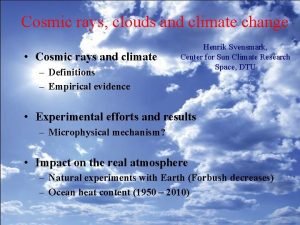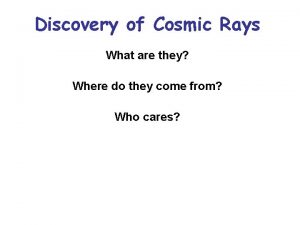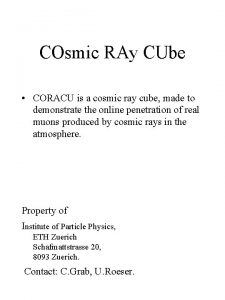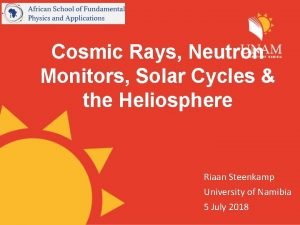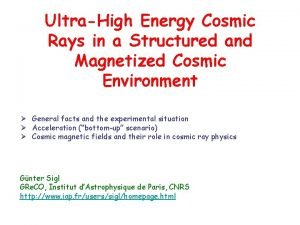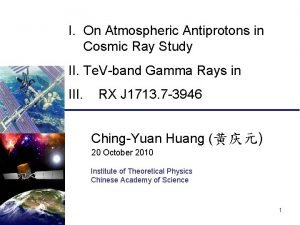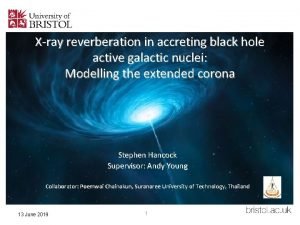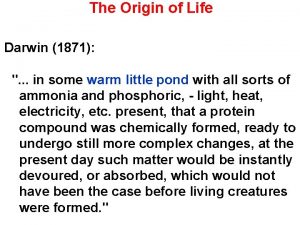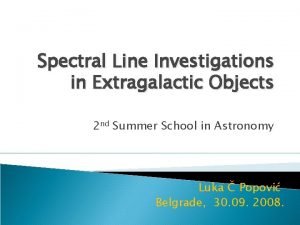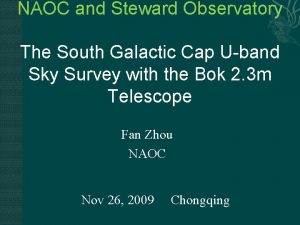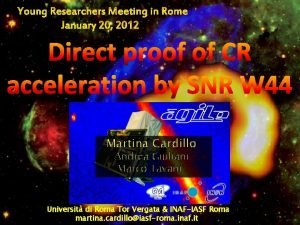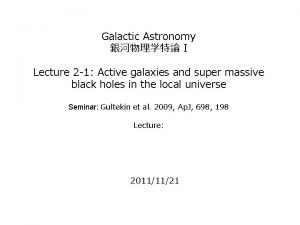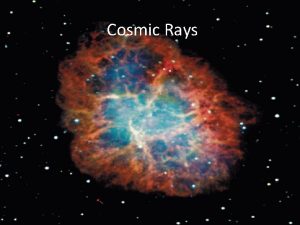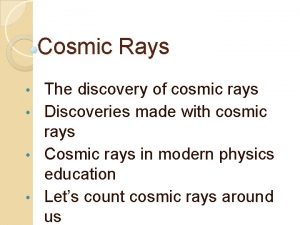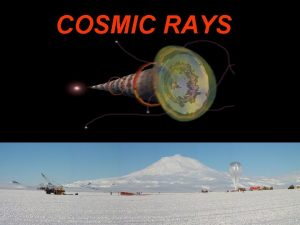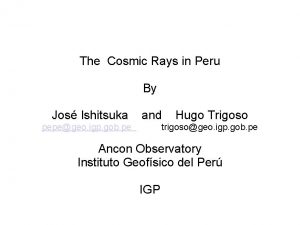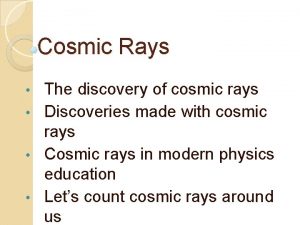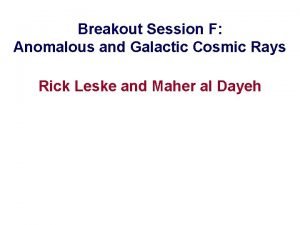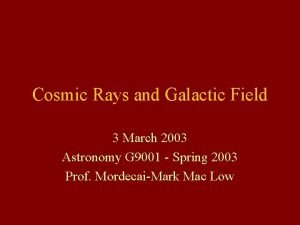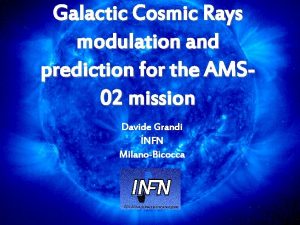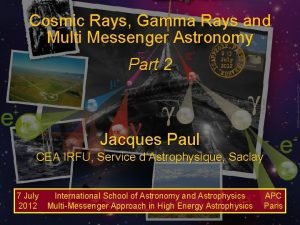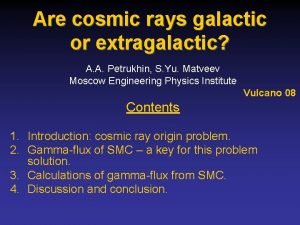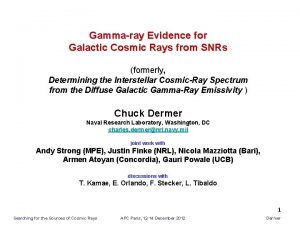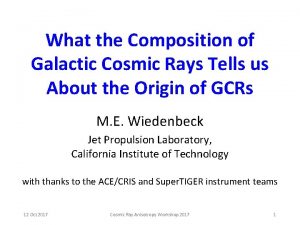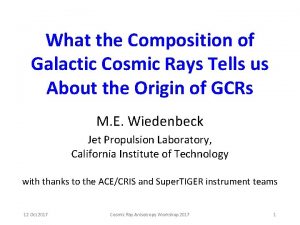Galactic Cosmic Rays and Climate Change Natia Porchkhidze




















- Slides: 20

Galactic Cosmic Rays and Climate Change Natia Porchkhidze (Ilia State University)

Reasons of the climate change • Natural • Anthropogenic

One of the most important natural reason is Cosmic factor

An influence of GCRs on the climate change is under increased -interest last decade (CERN CLOUD experiment).

GCR-s have influence on atmospheric structure, because they(Secondary ones) can create cloud condensation nucleus and have influence on cloud covering


Cloud covering influences on radiative balance at the Earth’s surface and its consequence on the planet’s climate

On the cloudy days, solar visible electromagnetic radiation is reflected and reduced it’s absorption by the planet’s surface On the cloudy nights, they scatter and partly send back the Earth’s infrared thermal radiation.

• To estimate more exactly influence of GCRs on cloud covering and climate needs consideration sensitivity of day and nighttime cloud covering processes under influence of GCRs • To consider a possible influence of GCRs on day and nighttime cloud covering is used the data of Abastumani Astrophysical Observatory at ilia state university (during 1957 -1993) and GCRs flux changes from Rome Neutron Monitor data ( includes data set during 1957 -1993. Geomagnetic cut-off rigidity is close to our region 6 -7 Gev(For Tbilisi Rc=6. 91 Gev and for Rome Rc=6. 32 Gev)).

The Observed and corrected data with pressure are compared to each in different cases •

Long-term trends for spring and summer seasons Spring Observed Spring- Pressure corrected 0. 08 0. 06 0. 04 0. 02 Series 1 0 -0. 02 1 3 5 7 9 11 13 15 17 19 21 23 25 27 29 31 33 35 37 Linear(Series 0) -0. 02 -0. 04 -0. 06 -0. 08 -0. 1 Summer Observed 0. 08 0. 06 0. 04 0. 02 0 -0. 02 1 3 5 7 9 11 13 15 17 19 21 23 25 27 29 31 33 35 -0. 04 -0. 06 -0. 08 -0. 12 -0. 14 Series 1 0 1 3 5 7 9 11 13 15 17 19 21 23 25 27 29 31 33 35 Linear(Series 0) Summer-Pressure corrected Series 1 Linear(Series 0) 0. 08 0. 06 0. 04 0. 02 0 -0. 02 1 3 5 7 9 11 13 15 17 19 21 23 25 27 29 31 33 35 37 -0. 04 -0. 06 -0. 08 -0. 12 -0. 14 Series 1 Linear(Series 0)

Long-term trends for autumn and winter seasons Autumn Observed Autumn pressure corrected 0. 06 0. 04 0. 02 0 -0. 02 1 3 5 7 9 11 13 15 17 19 21 23 25 27 29 31 33 35 37 Series 1 Linear(Series 0) -0. 04 0 -0. 02 -0. 06 -0. 08 -0. 1 Winter observed Winter -Pressure corrected 0. 08 0. 06 0. 04 0. 02 -0. 02 Series 1 1 3 5 7 9 11 13 15 17 19 21 23 25 27 29 31 33 35 Series 1 Linear(Series 0) -0. 04 -0. 06 0 1 3 5 7 9 11 13 15 17 19 21 23 25 27 29 31 33 35 37 Series 1 0 Linear(Series 0) -0. 02 -0. 04 -0. 06 -0. 08 -0. 1 1 3 5 7 9 11 13 15 17 19 21 23 25 27 29 31 33 35 Linear(Series 0)

Long-term trends for CD-s and CN-s of spring season CD Pressure corrected CD Observed 0. 05 05 0. 04 04 0. 03 03 0. 02 02 0. 01 relative cd 02 Linear(relative cd) -0. 01 -0. 02 -0. 04 04 05 -0. 05 CN Pressure corrected CN-Observed 05 04 03 02 01 02 1 9 17 25 33 41 49 57 65 73 81 89 97 105 113 121 129 137 145 153 161 169 177 relative 0. 01 Series 1 0 01 Linear(relative) -0. 03 03 Linear(Series 0) 0 -0. 01 03 -0. 02 04 -0. 03 05 -0. 04 Linear(relative) 1 9 17 25 33 41 49 57 65 73 81 89 97 105 113 121 129 137 145 153 161 169 177 01 1 32 63 94 125 156 187 218 249 280 311 342 373 404 435 466 497 0 relative 0 1 32 63 94 125 156 187 218 249 280 311 342 373 404 435 466 497 528 01

Long-term trends for CD-s and CN-s of summer season CD Pressure corrected 0. 04 CD Observed 0. 03 06 0. 02 04 0. 01 02 -0. 01 rel cd Linear(rel cd) -0. 02 relative cd Linear(relative cd) -0. 03 -0. 04 04 -0. 05 -0. 06 06 CN Pressure corrected CN Obsereved 0. 04 0. 06 0. 03 0. 02 0. 04 0. 01 0. 02 0 rel cn -0. 04 -0. 06 295 274 253 232 211 190 169 148 127 85 64 43 106 -0. 02 22 1 0 -0. 01 Linear(rel cn) -0. 02 -0. 03 -0. 04 -0. 05 -0. 06 1 22 43 64 85 106 127 148 169 190 211 232 253 274 295 02 1 52 103 154 205 256 307 358 409 460 511 562 613 664 715 766 817 868 919 970 0 1 62 123 184 245 306 367 428 489 550 611 672 733 794 855 916 977 0 relative cn Linear(relative cn)

Long-term trends for CD-s and CN-s of autumn season CD- Pressure corrected CD Observed 0. 03 0. 02 0. 01 relative 0 -0. 01 Linear(relat cd) -0. 02 1 42 83 124 165 206 247 288 329 370 411 452 493 534 575 616 657 698 739 relat cd 1 52 103 154 205 256 307 358 409 460 511 562 613 664 715 -0. 04 -0. 05 CN Observed CN- Pressure corrected 0. 04 0. 05 0. 03 0. 04 0. 02 0. 03 0. 01 0. 02 0 relat cn 0. 01 1 22 43 64 85 106 127 148 169 190 211 232 253 274 295 316 0 -0. 01 Linear(relat cn) -0. 02 -0. 03 -0. 02 -0. 04 -0. 03 -0. 05 -0. 04 Linear(relative) -0. 03 relative 1 22 43 64 85 106 127 148 169 190 211 232 253 274 295 316 0. 05 0. 04 0. 03 0. 02 0. 01 0 -0. 01 -0. 02 -0. 03 -0. 04 -0. 05 0. 04 Linear(relative)

Long-term trends for CD-s and CN-s of winter season CD-Pressure corrected CD Observed 0. 05 0. 04 0. 03 0. 02 0. 01 1 32 63 94 125 156 187 218 249 280 311 342 373 404 435 466 0 Linear(rel cd) . 02 -0. 01 Linear(Series 0) -0. 02 -0. 03 -0. 04 . 05 CN Observed CN-Pressure corrected 0. 05 0. 04 0. 03 0. 02 rel cn 0. 01 -0. 01 Linear(rel cn) 0 1 11 21 31 41 51 61 71 81 91 101 111 121 131 141 151 161 171 181 191 0 Series 1 0. 01 -0. 02 -0. 03 -0. 04 Linear(Series 0) 1 9 17 25 33 41 49 57 65 73 81 89 97 105 113 121 129 137 145 153 161 169 177 185 . 01 0 rel cd 1 32 63 94 125 156 187 218 249 280 311 342 373 404 435 466 . 01 Series 1

Conclusions: v The difference between long term trends of the cloudless days and cloudless nights show GCR flux influence of the Cloud coverage v CD and CN GCR trends have opposite behavior in the Summer and in the Winter. v This graphs show the importance of cosmic factor, which has not been in confidence before. v GCR effects on the Earth’s climate. v Direct consideration of GCR on Climate Change needs whole monitoring around the globe.

References • Dorman L. “Cosmic ray interactions, propagation, and acceleration in space plasmas’’ Springer 2006. • Didebulidze G. G. Todua M. “The inter-annual distribution of cloudless days and nights in Abastumani: Coupling with cosmic factors and climate change. “ “Journal of Atmospheric and Solar-Terrestrial physics’’, 2015. • Svensmark H. “Cosmic rays, clouds and climate. ” “Europhysics news’’ 2015 • https: //home. cern/about/updates/2016/10/cloudexperiment-sharpens-climate-predictions • http: //www. stce. be/esww 12/contributions/public/S 15 P 1/S 15 -P 1 -15 Gerontidou. Maria/ESWW 12_S 15_GERONTIDOU. pdf

Acknowledgements: I am grateful : • to SVIRCO NM for the GCR data • To Professors: Didebulidze G. , Todua M. and Dalakishvili G. for supervising and suggestions

Thank you for attention!
 Climate change 2014 mitigation of climate change
Climate change 2014 mitigation of climate change Cosmic rays and clouds
Cosmic rays and clouds Cosmic rays discoverer
Cosmic rays discoverer Cosmic ray cube
Cosmic ray cube Cosmic rays
Cosmic rays Cosmic rays
Cosmic rays Cosmic waves
Cosmic waves Galactic address
Galactic address African city model
African city model Swcombine factions
Swcombine factions Galactic city model example
Galactic city model example Galatic city model
Galatic city model Galactic center radio transients
Galactic center radio transients Reverberation
Reverberation Galactic habitable zone
Galactic habitable zone Active galactic nuclei
Active galactic nuclei Galactic phonics ure
Galactic phonics ure Galactic cap review
Galactic cap review Alessandro cardillo
Alessandro cardillo Galactic habitable zone
Galactic habitable zone Active galactic nuclei
Active galactic nuclei

